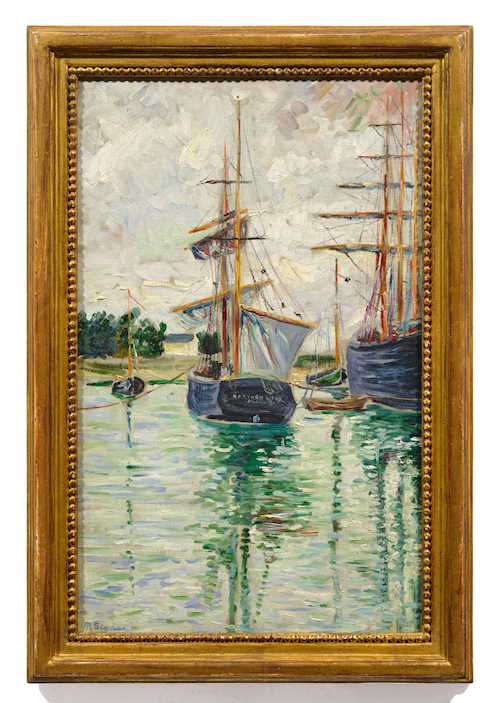
Lot 3205* - A211 Art Impressionniste & Moderne - vendredi, 29. novembre 2024, 17h00
PAUL SIGNAC
(1863 Paris 1935)
Port-en-Bessin. Brick. 1884.
Oil on canvas.
Signed lower left: P. Signac.
Signed and entitled verso on the stretcher: P. Signac Port-en-Bessin.
Signed and entitled verso on the stretcher: P. Signac Port-en-Bessin.
61.5 × 38 cm.
Provenance:
- With Galerie Goldschmidt, Frankfurt, purchased directly from the artist in 1921.
- Private collection in Frankfurt, purchased from the above gallery before 1932 and in the family for three generations.
Literature:
Paul Signac first visited the fishing village of Port-en-Bessin in 1882, at the age of just seventeen. The young artist was enchanted by this picturesque seaside town in Normandy and returned the following summer, then again in 1884. During this third stay, Signac created a series of about a dozen paintings showing views of the harbor and the nearby beach. The importance of this place for the painting of other Neo-Impressionists is illustrated by the fact that the pointillist painter Georges Seurat, probably on Signac’s recommendation, followed him to Port-en-Bessin four years later, in the summer of 1888. Seurat painted at least six of his own distinctive views of the place while visiting.
Signac’s painting “Port-en-Bessin. Brick” reflects his early admiration for the Impressionists, especially Claude Monet, who grew up in Normandy and painted the coast there in numerous series. In 1883, Signac visited an exhibition of Monet’s painting series from Varengeville and Pourville in the Paris gallery Durand-Ruel et Cie. This experience clearly influenced Signac’s own painting style. In this early work, Signac’s intensive engagement with the Impressionist technique, the free and flowing brushstroke, is clearly visible. At the same time, however, the work also indicates the further development of his own pictorial language, which is characterized by a kaleidoscopic arrangement of colors and striking, staccato-like brushstrokes, already seen in the reflection of the ship on the surface of the water in this painting.
The year 1884 represents a decisive turning point in the development of Signac’s artistic style. In July, he took part in the first Salon des Artistes Indépendants, where he met his future companions in Neo-Impressionism for the first time: Georges Seurat and Henri-Edmond Cross. As “Port-en-Bessin. Brick” shows, Signac had already begun to develop his own artistic vision at this time. As Signac expert and curator Marina Ferretti aptly notes: “His first works show two characteristics that were to define his work: a clear preference for frontal, geometric compositions with little perspectival depth and a particular love of color.” (Signac, exh. cat., Metropolitan Museum of Art, New York, 2001, p. 85)
Signac’s painting “Port-en-Bessin. Brick” reflects his early admiration for the Impressionists, especially Claude Monet, who grew up in Normandy and painted the coast there in numerous series. In 1883, Signac visited an exhibition of Monet’s painting series from Varengeville and Pourville in the Paris gallery Durand-Ruel et Cie. This experience clearly influenced Signac’s own painting style. In this early work, Signac’s intensive engagement with the Impressionist technique, the free and flowing brushstroke, is clearly visible. At the same time, however, the work also indicates the further development of his own pictorial language, which is characterized by a kaleidoscopic arrangement of colors and striking, staccato-like brushstrokes, already seen in the reflection of the ship on the surface of the water in this painting.
The year 1884 represents a decisive turning point in the development of Signac’s artistic style. In July, he took part in the first Salon des Artistes Indépendants, where he met his future companions in Neo-Impressionism for the first time: Georges Seurat and Henri-Edmond Cross. As “Port-en-Bessin. Brick” shows, Signac had already begun to develop his own artistic vision at this time. As Signac expert and curator Marina Ferretti aptly notes: “His first works show two characteristics that were to define his work: a clear preference for frontal, geometric compositions with little perspectival depth and a particular love of color.” (Signac, exh. cat., Metropolitan Museum of Art, New York, 2001, p. 85)
PAUL SIGNAC
CHF 80 000 / 140 000 | (€ 82 470 / 144 330)
Vendu pour CHF 175 000 (prix marteau)
Aucune responsabilité n'est prise quant à l´exactitude de ces informations.


